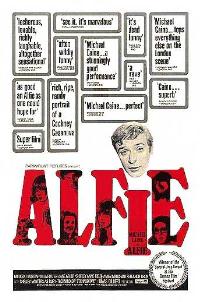A past example of British male representation is the 1966 film Alfie. The film stars Michael Caine as Alfie, a young man who leads a promiscuous lifestyle until some life reversals make him rethink his purposes and goals in life. The director and writer obviously aimed to target cultural issues of the time, after the Second World War people began to live more prosperous lifestyles and felt more freedom in their lifestyles. Alfie is an obvious example of this, he completely contrasts with the more traditional male stereotype in almost everything he does, causing the audience to believe in a more traditional attitude to aspects such as gender, status and abortion laws.
Later on in the film, Alfie is forced to change his attitude towards women as another naive young women, Annie, tries to do everything she can to please Alfie. However we becomes flippant with her, after telling her than he doesn't appreciate having the same type of food over and over again. This results in the first rebellion from a women against Alfie, as she packs her stuff and leaves without any command - this could be seen as a real turning point in Alfie's character.
Media Theorist David Gauntlett would suggest that “Media has a role in thinking about identity because media productions enable us to think about life through frames and narratives. These narratives have turning points and themes which we can reflect on life with.”
Media Theorist David Gauntlett would suggest that “Media has a role in thinking about identity because media productions enable us to think about life through frames and narratives. These narratives have turning points and themes which we can reflect on life with.”
Another example of British male representation is through TV show "Life on Mars". After being hit by a car in 2006, Sam Tyler awakes in 1973 and finds himself working for his predecessor at the same station and location as 2006. This contemporary production show the importance of power in Western society, we learn that Sam Tyler represents a very fast-paced, modern lifestyle who could stereotypically have an obsession with monetary value. Also Tyler awakes as a Detective Inspector, one rank lower than his 2006 rank of Detective Chief Inspector. Throughout both series Tyler appears confused about whether he has died, gone mad, in coma or has actually travelled back in time. From the audience's perspective it doesn't really matter how Tyler is now in 1973, it educates us all on how far equality has come, and the value of both men and women.
A key scene is where Sam tries to bring in the women officer when they are discussing a case, as she has a professional advantage with a Psychological degree. The was of-course quite controversial for the 1973 police officers, making it clear to our modern day audience how wrong their attitudes to equality and status were.
Tyrannosaur is our modern day example, the film completely destroys any male stereotypes we had before. The main character, Joseph, a lower class man suffering from depression after his wife's death, appears more violent and troubled. However, the film proves that our preconceptions of people are completely wrong. Infact Hannah, a Christian charity-shop worker, is the one who murders her own husband after being continually mistreated and abused. This is a huge shock for the audience, which is perhaps the aim of the director, causing us to realize that stereotypes are very misleading. Therefore, David Gauntlett's theory that we are all forced to choice an identity is also wrong as Tyrannosaur proves that we don't attempt to fit media stereotypes and often can contrast with these dramatically.
Looking to the future, it will be very difficult for media to represent anyone with the use of a stereotype. Although is it clear that we are gradually beginning to address issues of equality and gender through media, which can only be a good thing.







